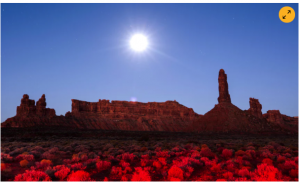Trump’s cuts to national monuments are an assault on our humanity – fight them


Monday, 4 December, in a much anticipated announcement, US President Donald Trump called for the reduction of Bears Ears National Monument by 84%, and Grand Staircase-Escalante National Monument by 50%. This is just the latest in a series of assaults on cultural heritage under this administration.
In October President Trump announced that the US would pull out of Unesco. It was disheartening, to say the least. This was not an decision that went un-remarked. Many cultural groups and institutions have condemned the attacks, and both the Washington Post and the Guardian have discussed how this move is part of a larger pattern of protectionism and withdrawal from the international community – at a time when, arguably, we need international cooperation more than ever, with 21st century issues such as climate change crossing national borders.
From a purely domestic point of view, the withdrawal from Unesco is also part of a pattern by the Trump administration to shrink our public lands and restrict our ability to study, protect, and preserve our heritage sites. A little more than ten days after withdrawing from Unesco, the administration proposed a steep fee hike for 17 of the most visited national parks in the American system, with some parks facing entrance fees of $70 (£52). Sure to decrease the number of visitors, this comes on top of a proposed budget decrease of $297m. This is also an undemocratic, classist maneuver to further marginalize poorer Americans and decrease their access to public lands that they deserve to enjoy.
Which brings us back to the Unesco withdrawal. One of the most visible programs run by Unesco is the designation of World Heritage Sites – places that are recognized as significant to all humanity, which allow us to understand who we are, or possess natural values that are celebrated across the globe. The US has 23 Unesco World Heritage sites, 20 of which are operated by the National Park Service. Nearly all of our World Heritage Sites are operated by a federal agency that has had its budget and personnel cut, is facing more threats to its budget, and has a $12bn backlog of deferred maintenance, much of which is for historic sites and properties.
Also in October, Utah Representative Rob Bishop introduced the National Monument Creation and Protection Act (H.R. 3990), or what many opponents are calling the “no new parks” bill. This bill, which passed out of committee without a hearing, would not only make it more difficult for a president to designate a national monument, but would also make it easier to reduce or un-designate a national monument, as Secretary Zinke and President Trump propose to do at Bears Ears. This is an attack on the 1906 Antiquities Act, the first piece of legislation that was established to protect archaeological sites in the United States, and gave us monuments and parks such as the Grand Canyon and Devil’s Tower.
Trump’s announcement regarding the reduction of national monuments included the assertion that “Some people think that the natural resources of Utah should be controlled by a small handful of very distant bureaucrats located in Washington”. This is the same false foundation that Bishop’s no-new-parks bill is built on – the insinuation that politicians somewhere else are making intimately local decisions. This is a dangerous falsehood on which to base such sweeping alterations to our public lands conservation laws. Never mind the fact that the federal employees who are tasked with the protection of these national monuments are citizens of the states in which these monuments are located, and have dedicated their careers to serving the American people. As former Department of Interior Secretary Sally Jewell has recently stated, the designation of Bears Ears was a long process with local input from important stakeholders, including local governments. Despite the description of the Antiquities Act as a method for a US president to unilaterally designate areas, the truth is that the process takes years, and hundreds of people, analyzing information and coming to compromises to set aside lands for the public benefit, in perpetuity.
This baseless claim also dismisses the Native American tribes who are the stewards of Bears Ears as outsiders, a distinction that has long been used by Anglo-Americans as a tool to disenfranchise Native Americans, and minimize their relationship to the very lands they call home. That Native Americans see these monuments as homelands is not an abstraction. All or part of the tribal lands for the Hopi, Navajo, Ute Mountain Ute, and the Ute Indian Tribe of the Uintah and Ouray Reservation are within the political boundaries of the state of Utah. Other tribes, including the Zuni, reside in nearby states. These are people with a direct geographic and temporal link to these buttes and mesas, to say nothing of their spiritual connection. Like the Bureau of Land Management and US Forest Service employees, these tribal peoples are locals.
The Antiquities Act was created specifically to end the destruction of archaeological sites in the American west. The attempts to disarm the Antiquities Act is a direct attack on archaeology in the United States. Our discipline will fundamentally change without the preservation offered by federal land conservation laws. The ability of Native Americans and other descent communities who have been separated – often by force – from these acres to have physical access to these places will end. Collectively we will lose the culture and heritage of thousands of years of human existence if these assaults continue.
There are many economic reasons that public lands and open space are a public benefit. Rural towns and municipalities, and those locals about whom Trump is expressing so much concern, benefit from the tourist dollars national parks and monuments bring, as well as additional access to careers with the federal government, and investment from federal monies. Land conservation is not simply about the economics, or the archaeological sites or the sage grouse or the cheap grazing for ranchers. Public lands conservation is about all those things bound up with the ribbon of intangibles. I am a passionate advocate of public lands for the impalpable experiences that these spaces provide – the ability to stretch our bodies on a trail, the compulsion to investigate the rocks and animals, the quiet stillness that is an escape from our modern world. The degradation of our public lands is a degradation of our humanity. The Trump administration is attempting to erode that humanity at the international, national, and local levels. We can’t let him.









